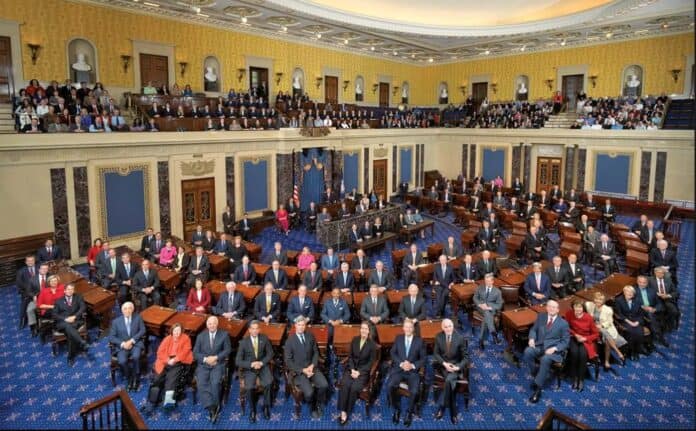The 2024 presidential election has grabbed most of the headlines recently, but the U.S. Senate races are taking shape under the radar. Here is a preview of the 10 most likely to flip.
West Virginia – Open (D): It’s not that often that every elections analyst in the country concurs on something, but I suspect you will get unanimous agreement that this seat is far and away the most likely Senate seat to flip. Joe Manchin is a Democrat who has basically been swimming against a Republican tide since he won the seat in a 2010 special election. Two years prior, John McCain carried the state by 12 points over Barack Obama. Donald Trump won it by almost 40 points in 2020. It’s unlikely that even the popular Manchin, who won narrowly in the good Democratic year of 2018, could emerge victorious, but with his retirement, the seat is just gone.
Montana – Jon Tester (D): Reasonable minds can disagree about whether Montana or Ohio is the more vulnerable seat. Tester is probably a better ideological match for his state than Sen. Sherrod Brown is for Ohio, but Montana will probably go for Donald Trump by 20 points rather than the 10 or so points by which he seems likely to carry Ohio. Tester’s preferred opponent, Matt Rosendale, dropped out of the race, giving Tester a more mainstream opponent. Even Rosendale had made a race out of it in the bad GOP year of 2018, but this time, Tester will likely have to convince one out of every six Trump voters to cross over for him. That’s no easy task.
Ohio – Sherrod Brown (D): Brown is probably too liberal for the modern Buckeye State, and he’ll have to convince around one in 10 Trump voters to split their tickets. This is within tolerance – Susan Collins pulled this off in reverse in 2020 – but it is still rare. Brown only won by seven points against an underfunded opponent in 2018, but whoever the GOP candidate is will probably not have to worry about money. Trump endorsed businessman Bernie Moreno, much to the state GOP’s dismay, but this is a state that voted for a similarly untested, controversial candidate in 2022 over Brown’s political heir. Brown can win, but he’s in trouble.
Michigan – Open (D): I have to make at least one controversial call, so why not here? To be clear, all of the remaining races at least lean toward the party that currently holds them. Why put this above more popular picks like Nevada, Arizona, or Wisconsin? The reason has less to do with this race than with the dynamics of the other races (discussed below). The Democratic Party has coalesced around Rep. Elissa Slotkin, which is good for the party. But there is a bit of schism within the Democratic Party right now over the Biden administration’s support of Israel in its war in Gaza. Trump has also been polling well in the state. A lot will depend on who emerges from the state’s crowded GOP primary, but remember, Trump nearly pulled now-Rep. John James across the finish line in 2020.
Texas – Ted Cruz (R): Another controversial call, I suspect. I’ve gone into this in greater detail elsewhere, but this is a state that is swinging leftward, and it wouldn’t take a particularly bad showing by Donald Trump nationally for it to flip. Not only that, but Cruz is, well, Cruz, and is not particularly well-liked. He almost lost in 2018, and while the environment is better for him this year, the state is worse. Again, this isn’t a tossup, but his edge is less pronounced than the remaining Democrats on this list.
Arizona – Open (D): Given Kari Lake’s post-election behavior and the presence of an abortion-rights referendum on the ballot, I’m skeptical that she is well-positioned to make this race competitive. It’s also why I’m somewhat skeptical about Donald Trump’s current polling lead against President Biden.
Nevada – Jacky Rosen (D): It’s not that the incumbent is particularly weak. Nor is the GOP field particularly strong. And the presence of an abortion-rights referendum will probably help Rosen. We’re starting to get into genuine long-shot territory here, but this is a state Donald Trump really might carry handily. We’ll see what comes out of the GOP primary.
Wisconsin – Baldwin (D): I don’t really think Tammy Baldwin is likely to lose. The danger to her comes if Donald Trump breaks out in the state and turns out to have coattails. But I promised 10 seats, and I aim to deliver 10.
Pennsylvania – Bob Casey (D): The GOP has its preferred candidate here, Dave McCormick (which it didn’t in 2022 when Oz Mehmet edged McCormick out in the primary), and Casey has never really had a tough challenge before. But he’s got a famous last name, and I think Trump has less chance of winning here than in Wisconsin. If Trump does pull ahead strongly, however, he probably has a better chance of bringing McCormick with him than he does in Wisconsin – whomever Republicans nominate in the Badger State.
Maryland – Open (D): I had to pick a race here. It was either this or New Jersey or Florida. I chose this one because GOP candidate Larry Hogan was a popular governor, is still well regarded in the state, and is probably the strongest challenger in the bunch. But Maryland is exceedingly blue and is really, really unlikely to flip.
This article was originally published by RealClearPolitics and made available via RealClearWire.
Sean Trende | RealClearPolitics
Go to Source
Reposted with permission


![Wisconsin Sen. Duey Stroebel Supports IVF, Birth Control [Fact Check] duey stroebel](https://www.wisconsinrightnow.com/wp-content/uploads/2024/10/MixCollage-22-Oct-2024-11-52-PM-8709-356x220.jpg)













